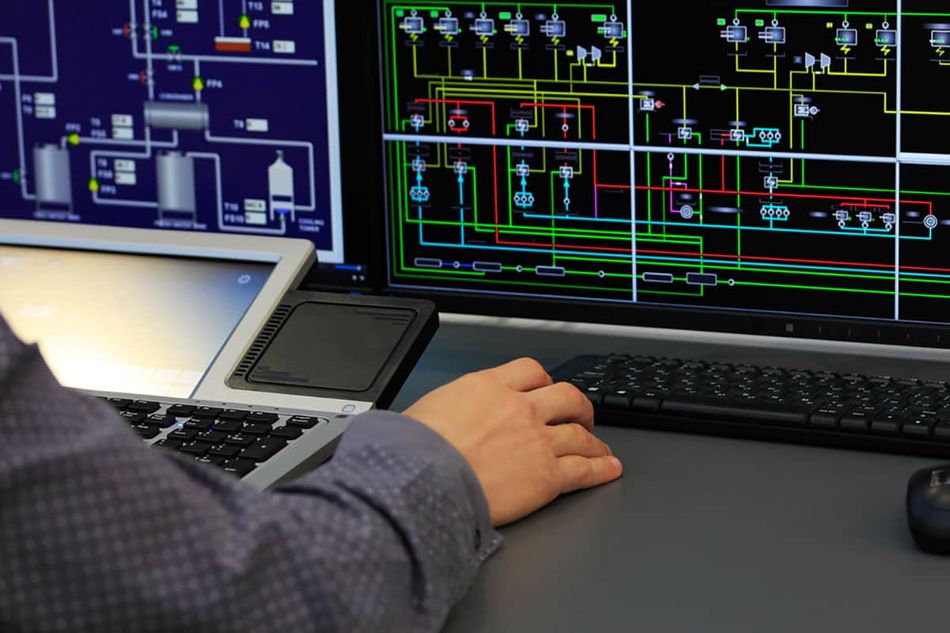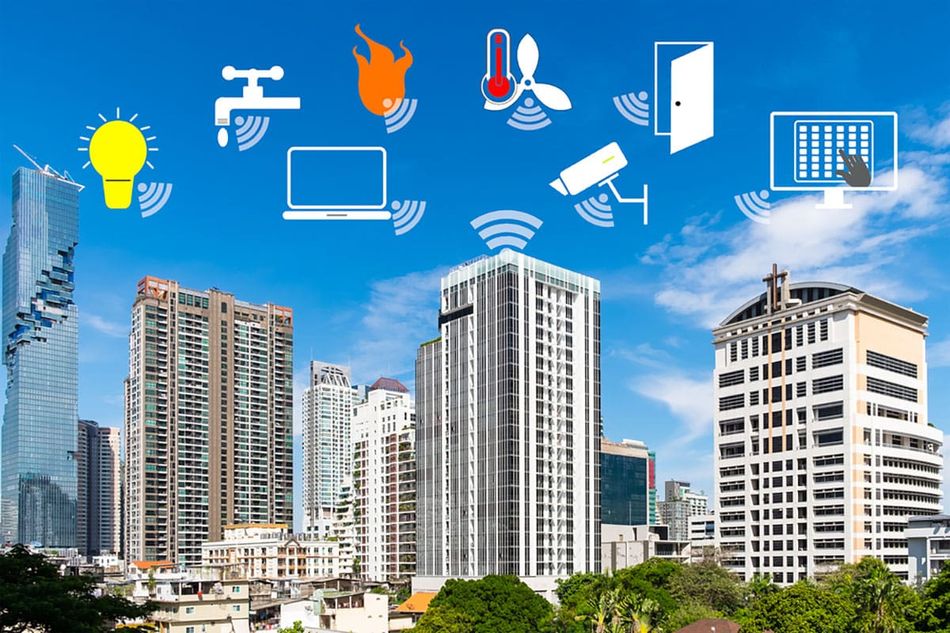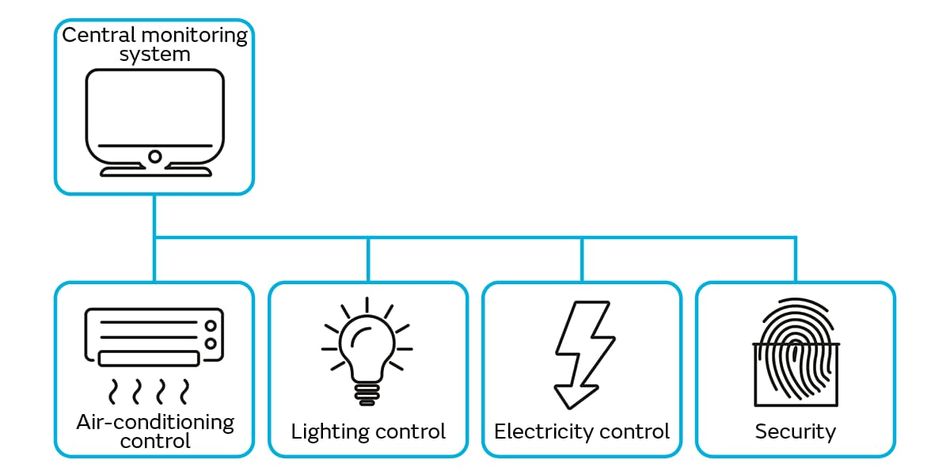Expanding Facility Management by Creating Smart Buildings with IoT Technologies.
The term "smart building" refers to buildings with a building management system that automatically manages and controls various types of energy used in the building, such as lighting, air-conditioning, and water heating, using technologies such as IoT and AI.
This article was first published on
article.murata.com1. What Is a Smart Building?
The term "smart building" refers to buildings with a building management system that automatically manages and controls various types of energy used in the building, such as lighting, air-conditioning, and water heating, using technologies such as IoT and AI. Smart buildings save energy, increase security, create a more comfortable environment, and can be managed more efficiently, reducing the burden on building management staff.
2. Building Management Issues
Due to the pandemic, office floor space is shrinking due to the increase of people working from home and hot desking at the office. In addition, rising labor wages and labor shortages are occurring in developing nations with rapid economic growth. Furthermore, the sharp rise in the price of crude oil and other raw materials due to terrorism and conflicts is becoming a serious problem.
In this section, we will look at the negative impact that problems such as the ones listed above can have on building management.

Rising wages and labor shortages - inefficient building management
Since the pandemic, the global economy has been characterized by rising prices caused by economic stagnation and inflation, while at the same time, rising labor wages have been observed in developing nations. The realm of building management is similarly affected, as raising starting salaries is unavoidable in order to secure staff. In addition, it is difficult to acquire building management expertise in developing nations, and the lack of knowledgeable technicians makes it difficult to introduce and use the latest technologies. As a result, many operations are carried out manually, making them inefficient, and, coupled with rising wages, this is becoming a significant encumbrance on building management.
Rising price of raw materials - increased management costs
The price of crude oil, natural gas, and other raw materials continues to rise due to uncertainty about the future caused by terrorism and conflicts in various parts of the world. As a result, energy prices are also soaring, and the cost of powering electrical equipment such as air-conditioning and lighting is on the increase. The rising price of raw materials is the root cause of increased maintenance and management costs for energy-intensive buildings. In addition, unlike other problems, these increasing prices are a global problem, making it impossible for a single company to solve it through managerial methods. Therefore, more drastic reforms, such as introducing the latest technologies, are required.
Reduced office floor space - decreased contract prices
Introduced in response to the pandemic, working from home has brought economic benefits to companies in the form of reduced floor rents due to shrinking offices. In addition, the concerns that were foreseen regarding communication problems are being alleviated with the help of online meetings and hot desking at the office.
This phenomenon has led to a fall in the price of contracts for building management services due to a surplus of floors.
3. Initiatives to Make Buildings Smart - Breakthroughs Achieved through IoT
There are many different approaches to addressing these building management issues. Let's take a look at some of the key initiatives.

Optimization - utilizing the network
Sensors are installed throughout the building and data is collected via the network. Building managers receive a variety of data in real time, allowing them to manage the building efficiently from a central location. Furthermore, cloud services can be utilized to monitor buildings remotely.
Energy management - introducing sensing technology
Sensors and cameras that measure temperature, humidity, CO2 concentration, brightness, the flow of people, etc., are installed throughout the building and the data from them is collected via the network and utilized in energy management. Analyzing the data collected from the sensors and cameras makes it possible to optimize energy usage.
Approaches being taken in existing buildings and facilities other than office buildings
Initiatives to make buildings smart are not limited to new construction projects. During major renovation of existing buildings, even simply installing energy-saving equipment or security equipment can be highly effective. In addition, the ability to collect and analyze different types of data in the building, such as the number of people coming and going and the amount of users in different time periods, can be used for marketing research purposes in commercial buildings.
4. The Benefits of Smart Buildings
What are the merits of making a building smart, enabled by the latest technology? In this section, we will introduce four of the main benefits.

Expanding the facility management area that can be handled by a single person through the introduction of IoT technologies
Utilizing cloud computing technology makes it possible to remotely monitor and manage energy consumption and interior environments from a central location.
In addition to visualizing power consumption and the interior environment, cloud services can be used to manage multiple buildings from one location. If buildings can be monitored remotely, then there is no need to assign staff to each building, only dispatching staff to the actual site when a problem occurs.
Introducing IoT technologies in this way is a useful approach that solves the problems of labor shortages and the lack of knowledgeable technicians, while also expanding the facility management area that can be handled by a single person.
Energy saving and predictive maintenance
By analyzing the data that shows the usage of electricity, gas, water, etc., and linking the analysis results with the operation of equipment that consumes energy, it is possible to efficiently optimize energy consumption within the building.
Since energy consumption is being constantly monitored in a smart building, this lets you know not only the energy consumption, but also the operating status of equipment in the building. By controlling equipment that consumes energy in combination with this data, you can achieve optimum energy saving. In addition, this makes it possible to carry out predictive maintenance: detecting and responding to equipment failures and other abnormalities at an early stage, before they become a problem.
Improving the interior environment
Visualizing and analyzing data on the interior environment, such as temperature and CO2 concentration, makes it possible to carry out appropriate air-conditioning and ventilation, making it more pleasant for facility users and residents. For example, in a smart building, the indoor CO2 concentration and distribution can be obtained using sensors, and the amount of external air intake can be adjusted based on the CO2 concentration. This prevents excessive intake of the outside air, which in turn reduces the energy required for air-conditioning.
Enhanced security and safety
Intruders can be detected with cameras and sensors installed in the building. It is also possible to manage employee attendance and seating by scanning employees' ID cards or their veins. In addition, temperature sensors can be used to detect fires.
In addition to detecting intruders and fires, smart buildings can be linked to alarms and alarm systems, ensuring a swift response in an emergency.
5. BAS and BEMS
In smart building management, the terms "BAS" and "BEMS" are often used. These two terms are essential technical terms in building management, and in this section, we will explain their meaning and the relationship between them.
BAS
Short for "Building Automation System," which refers to a system that automates various equipment and facilities within the building, and allows them to be managed centrally. BAS is a central monitoring system that monitors and controls the operation and energy consumption of equipment such as air-conditioning, lighting, and security.

BEMS
Short for "Building Energy Management System." BEMS is a system that visualizes and manages energy consumption, such as gas and electricity, based on data obtained from sensors installed on floors, in rooms, and in equipment. Although similar to BAS, BEMS is a system that builds on BAS, specializing in visualizing the operation and energy consumption of all equipment within the building. In addition to visualizing energy consumption, analyzing the data obtained from the sensors makes it possible to control the energy supply in a unified and efficient manner, resulting in energy savings and a more agreeable environment.

Relationship between BAS and BEMS
Understanding current energy use is the key to success for achieving energy savings. Data that reveals energy usage can be gathered through the use of the BAS sensors and network. This data is visualized in the BEMS in the form of graphs and charts. This allows you to identify any excessive energy use. In other words, the BEMS is a system that adds energy management functionality to the BAS.
The introduction of a BEMS built on top of a BAS is an essential step for making smart buildings that aim to save energy, create a more comfortable environment, and reduce the burden on building management staff.
6. Summary - What Can Smart Buildings Provide?
Smart buildings are made possible through the latest building management technology based on IoT technologies. They deliver a number of benefits, including energy savings, enhanced security, and expanding the facility management area that can be handled by a single person. They also engender building management that remains resilient in the face of problems such as pandemics and the global rise in price of raw materials. These benefits are thanks to practical technologies that contribute to stabilizing operations in the building management industry, and allow the freedom to work on more complex operations.
